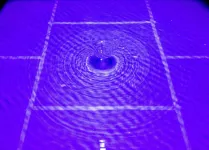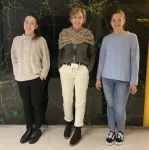INFORMATION:
This research was supported, in part, by the Department of Energy, the National Science Foundation, the Gordon and Betty Moore Foundation, and the Ramon Areces Foundation.
Written by Jennifer Chu, MIT News Office
Physicists create tunable superconductivity in twisted graphene 'nanosandwich'
Structure may reveal conditions needed for high-temperature superconductivity
2021-02-01
(Press-News.org) When two sheets of graphene are stacked atop each other at just the right angle, the layered structure morphs into an unconventional superconductor, allowing electric currents to pass through without resistance or wasted energy.
This "magic-angle" transformation in bilayer graphene was observed for the first time in 2018 in the group of Pablo Jarillo-Herrero, the Cecil and Ida Green Professor of Physics at MIT. Since then, scientists have searched for other materials that can be similarly twisted into superconductivity, in the emerging field of "twistronics." For the most part, no other twisted material has exhibited superconductivity other than the original twisted bilayer graphene, until now.
In a paper appearing in Nature, Jarillo-Herrero and his group report observing superconductivity in a sandwich of three graphene sheets, the middle layer of which is twisted at a new angle with respect to the outer layers. This new trilayer configuration exhibits superconductivity that is more robust than its bilayer counterpart.
The researchers can also tune the structure's superconductivity by applying and varying the strength of an external electric field. By tuning the trilayer structure, the researchers were able to produce ultra-strongly coupled superconductivity, an exotic type of electrical behavior that has rarely been seen in any other material.
"It wasn't clear if magic-angle bilayer graphene was an exceptional thing, but now we know it's not alone; it has a cousin in the trilayer case," Jarillo-Herrero says. "The discovery of this hypertunable superconductor extends the twistronics field into entirely new directions, with potential applications in quantum information and sensing technologies."
His co-authors are lead author Jeong Min Park and Yuan Cao at MIT, and Kenji Watanabe and Takashi Taniguchi of the National Institute of Materials Science in Japan.
A new super family
Shortly after Jarillo-Herrero and his colleagues discovered that superconductivity could be generated in twisted bilayer graphene, theorists proposed that the same phenomenon might be seen in three or more layers of graphene.
A sheet of graphene is an atom-thin layer of graphite, made entirely of carbon atoms arranged in a honeycomb lattice, like the thinnest, sturdiest chicken wire. The theorists proposed that if three sheets of graphene were stacked like a sandwich, with the middle layer rotated by 1.56 degrees with respect to the outer layers, the twisted configuration would create a kind of symmetry that would encourage electrons in the material to pair up and flow without resistance -- the hallmark of superconductivity.
"We thought, why not, let's give it a try and test this idea," Jarillo-Herrero says.
Park and Cao engineered trilayer graphene structures by carefully slicing a single gossamer sheet of graphene into three sections and stacking each section on top of each other at the precise angles predicted by the theorists.
They made several trilayer structures, each measuring a few micrometers across (about 1/100 the the diameter of a human hair), and three atoms tall.
"Our structure is a nanosandwich," Jarillo-Herrero says.
The team then attached electrodes to either end of the structures, and ran an electric current through while measuring the amount of energy lost or dissipated in the material.
"We saw no energy dissipated, meaning it was a superconductor," Jarillo-Herrero says. "We have to give credit to the theorists -- they got the angle right."
He adds that the exact cause of the structure's superconductivity -- whether due to its symmetry, as the theorists proposed, or not -- remains to be seen, and is something that the researchers plan to test in future experiments.
"For the moment we have a correlation, not a causation," he says. "Now at least we have a path to possibly explore a large family of new superconductors based on this symmetry idea."
"The biggest bang"
In exploring their new trilayer structure, the team found they could control its superconductivity in two ways. With their previous bilayer design, the researchers could tune its superconductivity by applying an external gate voltage to change the number of electrons flowing through the material. As they dialed the gate voltage up and down, they measured the critical temperature at which the material stopped dissipating energy and became superconductive. In this way, the team was able to tune bilayer graphene's superconductivity on and off, similar to a transistor.
The team used the same method to tune trilayer graphene. They also discovered a second way to control the material's superconductivity that has not been possible in bilayer graphene and other twisted structures. By using an additional electrode, the researchers could apply an electric field to change the distribution of electrons between the structure's three layers, without changing the structure's overall electron density.
"These two independent knobs now give us a lot of information about the conditions where superconductivity appears, which can provide insight into the key physics critical to the formation of such an unusual superconducting state," Park says.
Using both methods to tune the trilayer structure, the team observed superconductivity under a range of conditions, including at a relatively high critical temperature of 3 kelvins, even when the material had a low density of electrons. In comparison, aluminum, which is being explored as a superconductor for quantum computing, has a much higher density of electrons and only becomes superconductive at about 1 kelvin.
"We found magic-angle trilayer graphene can be the strongest coupled superconductor, meaning it superconducts at a relatively high temperature, given how few electrons it can have," Jarillo-Herrero says. "It gives the biggest bang for your buck."
The researchers plan to fabricate twisted graphene structures with more than three layers to see whether such configurations, with higher electron densities, can exhibit superconductivity at higher temperatures, even approaching room temperature.
"If we could make these structures as they are now, at industrial scale, we could make superconducting bits for quantum computation, or cryogenic superconductive electronics, photodetectors, etc. We haven't figured out how to make billions of these at a time," Jarillo-Herrrero says.
"Our main goal is to figure out the fundamental nature of what underlies strongly coupled superconductivity," Park says. "Trilayer graphene is not only the strongest-coupled superconductor ever found, but also the most tunable. With that tunability we can really explore superconductivity, everywhere in the phase space."
ELSE PRESS RELEASES FROM THIS DATE:
The first steps toward a quantum brain
2021-02-01
An intelligent material that learns by physically changing itself, similar to how the human brain works, could be the foundation of a completely new generation of computers. Radboud physicists working toward this so-called "quantum brain" have made an important step. They have demonstrated that they can pattern and interconnect a network of single atoms, and mimic the autonomous behaviour of neurons and synapses in a brain. They report their discovery in Nature Nanotechnology on 1 February.
Considering the growing global demand for computing capacity, more and more data centres are necessary, all of which leave an ever-expanding energy footprint. 'It is clear that ...
Astronomers detect extended dark matter halo around ancient dwarf galaxy
2021-02-01
The Milky Way is surrounded by dozens of dwarf galaxies that are thought to be relics of the very first galaxies in the universe. Among the most primitive of these galactic fossils is Tucana II -- an ultrafaint dwarf galaxy that is about 50 kiloparsecs, or 163,000 light years, from Earth.
Now MIT astrophysicists have detected stars at the edge of Tucana II, in a configuration that is surprisingly far from its center but nevertheless caught up in the tiny galaxy's gravitational pull. This is the first evidence that Tucana II hosts an extended dark matter halo ...
New realm of personalized medicine with brain stimulation
2021-02-01
Millions of patients suffering from neurological and mental disorders such as depression, addiction, and chronic pain are treatment-resistant. In fact, about 30% of all major depression patients do not respond at all to any medication or psychotherapy. Simply put, many traditional forms of treatment for these disorders may have reached their limit. Where do we go from here?
Research to be published in Nature Biomedical Engineering led by Maryam Shanechi, the Andrew and Erna Viterbi Early Career Chair in electrical and computer engineering at the USC Viterbi School of Engineering, ...
New study strengthens claims Richard III murdered 'the Princes in the Tower
2021-02-01
King Richard III's involvement in one of the most notorious and emotive mysteries in English history may be a step closer to being confirmed following a new study by Professor Tim Thornton of the University of Huddersfield.
Richard has long been held responsible of the murder of his nephews King Edward V and his brother, Richard, duke of York - dubbed 'the Princes in the Tower' - in a dispute about succession to the throne. The pair were held in the Tower of London, but disappeared from public view in 1483 with Richard taking the blame following his death two years later.
It has become of the most enduring unsolved mysteries of all, stoked by references in Shakespeare's play about the ...
Skoltech imaging resources used in international experiment with new photocatalysts
2021-02-01
Skoltech researchers helped their colleagues from Japan, Germany, the United States, and China study the crystal structure and optical properties of a new class of two-dimensional compounds, which can be used as effective visible-light-responsive photocatalysts for energy and chemical conversion. They used the Advanced Imaging Core Facility equipment for imaging and structural analysis. The paper was published in the Journal of the American Chemical Society.
One potential use of photocatalysts, so-called water splitting can help substitute climate-warming fossil fuels with more environmentally friendly hydrogen. For this process to work on ...
A study reveals that the brain distributes sensory information highly efficiently
2021-02-01
It has sometimes been suggested that humans use a tiny fraction of their brains. But, is this statement true? The authors of a study published on 20 January in the journal Nature Communications answer this question using neural records of mice subjected to visual stimuli.
This paper demonstrates, in the visual system of mice, the presence of a type of coordination of neural activity called differential correlations. A study by Rubén Moreno-Bote, a researcher at the Center for Brain and Cognition (CBC) and Serra Hunter research professor with the UPF Department of Information and Communication Technologies ...
Backreaction observed for first time in water tank black hole simulation
2021-02-01
Scientists have revealed new insights into the behaviour of black holes with research that demonstrates how a phenomenon called backreaction can be simulated.
The team from the University of Nottingham have used their simulation of a black hole, involving a specially designed water tank, for this latest research published in Physical Review Letters. This study is the first to demonstrate that the evolution of black holes resulting from the fields surrounding them can be simulated in a laboratory experiment.
The researchers used a water tank simulator consisting of a draining vortex, like the one that forms when you pull the plug in the bath. This mimics a black hole since a wave which comes too ...
Researchers describe a molecular mechanism involved in the pathology's neurodegeneration
2021-02-01
Protein alteration in the family of lamins causes several diseases, known as laminopathies, such as progeria or precocious ageing. A study in which UB researchers have taken part states that alterations in the levels of one of these proteins, lamin B1, contribute to the degeneration of different brain neuronal populations in Huntington's disease. Caused by a mutation in the huntingtin gen, this pathology features involuntary movements, cognitive deficit and psychiatric disorders, and has no cure yet.
According to the study, published in the journal EMBO Molecular Medicine, these results open new therapeutic pathways for the treatment of this disease, since research shows pharmacological normalization of levels of lamin ...
How governments address COVID-19 misinformation--for better or for worse
2021-02-01
As COVID-19 spread across the world, so did conspiracy theories and false information about the virus. This proliferation of misinformation--labeled an "infodemic" by the World Health Organization (WHO)--makes it difficult to identify trustworthy sources and can threaten public health by undermining confidence in science, governments, and public health recommendations.
The consequences of misinformation can be tragic: hundreds died and thousands were poisoned in Iran after consuming toxic methanol alcohol, falsely believing it could cure COVID-19.
In a new article in the Journal of Public ...
Data shows strain on ICU capacity leads to more deaths during COVID-19 pandemic
2021-02-01
The COVID-19 pandemic is straining health systems across the country, especially intensive care units. New research from the U.S. Department of Veterans Affairs, Regenstrief Institute and Indiana University School of Medicine shows that people treated in the ICU for COVID-19 are twice as likely to die when the ICU capacity is strained by the number of COVID-19 patients.
"These results demonstrate that patients with COVID-19 are more likely to die if they are admitted to an ICU during times with peak COVID-19 caseload," said Dawn Bravata, M.D., first author of the study. "We know that strain on hospital ...
LAST 30 PRESS RELEASES:
Numbers in our sights affect how we perceive space
SIMJ announces global collaborative book project in commemoration of its 75th anniversary
Air pollution exposure and birth weight
Obstructive sleep apnea risk and mental health conditions among older adults
How talking slows eye movements behind the wheel
The Ceramic Society of Japan’s Oxoate Ceramics Research Association launches new international book project
Heart-brain connection: international study reveals the role of the vagus nerve in keeping the heart young
Researchers identify Rb1 as a predictive biomarker for a new therapeutic strategy in some breast cancers
Survey reveals ethical gaps slowing AI adoption in pediatric surgery
Stimulant ADHD medications work differently than thought
AI overestimates how smart people are, according to HSE economists
HSE researchers create genome-wide map of quadruplexes
Scientists boost cell "powerhouses" to burn more calories
Automatic label checking: The missing step in making reliable medical AI
Low daily alcohol intake linked to 50% heightened mouth cancer risk in India
American Meteorological Society announces Rick Spinrad as 2026 President-Elect
Biomass-based carbon capture spotlighted in newly released global climate webinar recording
Illuminating invisible nano pollutants: advanced bioimaging tracks the full journey of emerging nanoscale contaminants in living systems
How does age affect recovery from spinal cord injury?
Novel AI tool offers prognosis for patients with head and neck cancer
Fathers’ microplastic exposure tied to their children’s metabolic problems
Research validates laboratory model for studying high-grade serous ovarian cancer
SIR 2026 delivers transformative breakthroughs in minimally invasive medicine to improve patient care
Stem Cell Reports most downloaded papers of 2025 highlight the breadth and impact of stem cell research
Oxford-led study estimates NHS spends around 3% of its primary and secondary care budget on the health impacts of heat and cold in England
A researcher’s long quest leads to a smart composite breakthrough
Urban wild bees act as “microbial sensors” of city health.
New study finds where you live affects recovery after a hip fracture
Forecasting the impact of fully automated vehicle adoption on US road traffic injuries
Alcohol-related hospitalizations from 2016 to 2022
[Press-News.org] Physicists create tunable superconductivity in twisted graphene 'nanosandwich'Structure may reveal conditions needed for high-temperature superconductivity


